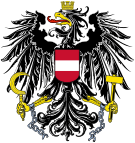From Wikipedia, the free encyclopedia
1953 Austrian legislative election
First party
Second party
Leader
Leopold Figl
Adolf Schärf
Party
ÖVP
SPÖ
Leader since
20 December 1945
15 December 1945
Last election
77 seats, 44.03%
67 seats, 38.71%
Seats won
74
73
Seat change
Popular vote
1,781,777
1,818,517
Percentage
41.26%
42.11%
Swing
Third party
Fourth party
Leader
Herbert Kraus
Johann Koplenig
Party
VdU
KPÖ
Leader since
25 March 1949
1924
Last election
16, 11.67%
5 seats, 5.08%
Seats won
14
4
Seat change
Popular vote
472,866
228,159
Percentage
10.95%
5.28%
Swing
Results of the election, showing seats won by constituency and nationwide. Constituencies are shaded according to the first-place party.
The elections to the Austrian National Council of 1953 were the first National Council elections after World War II in which the Socialist Party managed to gain a bare plurality of votes, the first time it had won the most votes in an election since 1920. However, the Austrian People's Party retained a one-seat plurality. The grand coalition between the two parties was continued with Julius Raab replacing Leopold Figl as Chancellor of Austria , who had had to resign after facing criticism from his own party, and Adolf Schärf of the Socialist Party remaining Vice Chancellor .[1] [2]
Results [ ]
Summary of the 22 February 1953 National Council of Austria election results
Parties
Votes
+/-
%
+/-
Seats
+/-
Socialist Party of Austria (Sozialistische Partei Österreichs )
1,818,517
+194,993
42.11
+3.4
73
+6
Austrian People's Party (Österreichische Volkspartei )
1,781,777
-64,804
41.26
-2.7
74
-3
Electoral Party of Independents (Wahlpartei der Unabhängigen )
472,866
-16,407
10.95
-0.8
14
-2
Communist Party of Austria (Kommunistische Partei Österreichs )1
228,159
+15,093
5.28
+0.2
4
-1
Bipartisan Agreement of the Centre
5,809
0.1
0
Christian Democratic Party
3,668
0.1
0
Christian Social Party and Non-Party Personalities
3,029
0.1
0
Free Democrats
2,573
0.1
0
Association of Austrian Monarchists
1,210
0.0
0
Austrian National Republicans and Independents
1,054
0.0
0
Austrian Patriotic Party
26
+26
0.0
–
0
0
Invalid/blank votes
76,831
–
–
–
–
–
Total (turnout 95.8%)
4,395,519
100
165
1 Contested the election as Electoral group Austrian People's Opposition (Wahlgemeinschaft Österreichische Volksopposition )
Source: Source: Nohlen, D & Stöver, P (2010). Elections in Europe: A data handbook . p. 214.
Popular vote
SPÖ
42.11%
ÖVP
41.26%
VdU
10.95%
VO
5.28%
Other
0.40%
Parliamentary seats
ÖVP
44.85%
SPÖ
44.24%
VdU
8.48%
VO
2.42%
References [ ]
Categories :
Elections in Austria 1953 elections in Austria Austrian Parliament Hidden categories:
Webarchive template wayback links Pages using bar box without float left or float right







